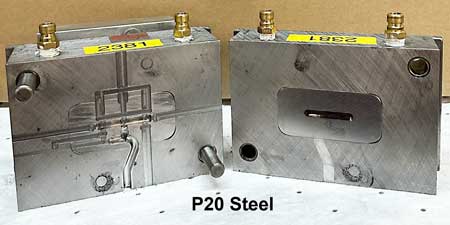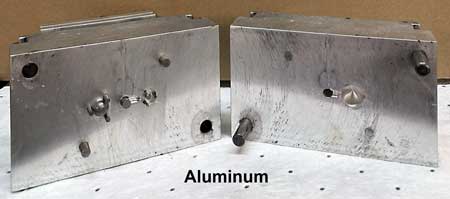 When it comes to creating prototype molds for injection molding, choosing the right material is crucial. Two common options for prototype mold construction are aluminum and soft steel (P20). Today, we’ll compare these two materials to help you make an informed decision. For the purposes of today’s discussion, we’ll be talking about “late stage” prototype molds. These are molds that are likely to be used for medium to high volume production runs, not just to knock out a few early-stage prototypes.
When it comes to creating prototype molds for injection molding, choosing the right material is crucial. Two common options for prototype mold construction are aluminum and soft steel (P20). Today, we’ll compare these two materials to help you make an informed decision. For the purposes of today’s discussion, we’ll be talking about “late stage” prototype molds. These are molds that are likely to be used for medium to high volume production runs, not just to knock out a few early-stage prototypes.
Durability/Production Life – P20 steel, although a soft steel, is stronger and more durable than aluminum. It will certainly endure a higher number of injection cycles as result. Further, steel’s strength means better mold integrity over time. Since aluminum is softer, molds made from it are more likely to deform eventually, requiring either repair or replacement, depending on how severe the deformity is.
 Heat Conduction – aluminum dissipates heat quickly and efficiently, meaning reduced cooling time during the injection molding process. Steel holds heat longer, leading to extended cooling times, which could lengthen production time. Also consider the required melting point of the material being molded. For those that require higher values, steel is the way to go.
Heat Conduction – aluminum dissipates heat quickly and efficiently, meaning reduced cooling time during the injection molding process. Steel holds heat longer, leading to extended cooling times, which could lengthen production time. Also consider the required melting point of the material being molded. For those that require higher values, steel is the way to go.
Machinability – since aluminum is a softer material, it’s generally easier to machine than steel. This is particularly useful if changes still need to be made to the mold before putting it to work on longer production runs. However, when it comes to high precision, steel would be the better choice.
Part Geometry/Size – since steel can be more easily machined to high precision, and is durable, it works much better for parts with complex geometries, especially over longer runs.
Cost – we saved the best for last. In fact, if we started with the cost aspects, you might not have read this all the way through! As you could probably guess, a domestically sourced aluminum mold is going to be less expensive than a steel mold. No doubt about that. But I’m going to share a valuable secret with you: if you source a mold from a quality oversees mold maker in China, there is little difference in the cost between an aluminum and steel mold. This is simply since labor costs are much lower. While there is still a difference in the cost of the material itself, and it takes longer to machine P20 steel, the differences become negligible when considering the final cost of the mold.
I know what you’re thinking – what about shipping and tariffs? Don’t they wipe out the reduced labor cost advantage? The answer is no. In fact, molds sourced overseas still typically cost about half, saving tens-of-thousands of dollars, even after the extras are added to the price. They are also able to produce them quickly, negating the longer shipping distance. And quality? That’s always going to be a concern. No matter where you source from, you’ll still need to do your homework to make sure you are working with a reputable supplier that has a documented quality program in place.
Who Wins, Aluminum or Steel?
So, what to choose? In most cases, an outsourced mold made from P20 steel will be your best decision. When price is essentially off the table, why wouldn’t you want a mold that’s more durable, will maintain its integrity, and can handle considerably more injection molding cycles? Sure, there are exceptions where locally sourced aluminum molds are a better choice, such as earlier stage prototyping. For some jobs where there are ITAR or other domestic sourcing mandates at play, there’s no choice. Otherwise, if you’re getting ready for mid-high volume/repeat production runs, we recommend an outsourced P20 steel mold. It will last longer, and have a lower lifetime cost.
Not sure which material is best for your mold?
Contact us, we’re happy to help you make the right selection!

Comments are closed